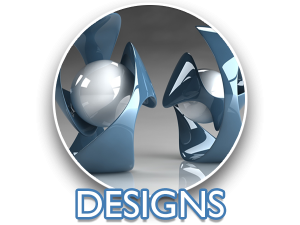DESIGNS
Matters relating to registered designs in South Africa are governed by the Designs Act 195 of 1993.A registered design is generally used to protect the physical appearance of an article and is normally judged solely by the eye. This may be contrasted with a patent which protects functional aspects of an invention or methods or principles of construction. However, in the case of a functional design, the design may have features which are necessitated by the function which the article to which the design is applied is to perform. Thus, there may be some overlap between the protection afforded by a registered design and that afforded by a patent. Registered designs and patents are not mutually exclusive and, where appropriate, a registered design and a patent may be registered for the same article.A registered design may protect a two-dimensional design, such as that applied to a textile, for example. In such a case, design protection may overlap with the protection afforded by copyright in the artistic work comprising the design.
Where a design is applied to a container, the protection afforded by the registered design may overlap with the protection available under the Trade Marks Act 194 of 1993, which permits the registration of a trade mark for a container for goods.
TYPES OF DESIGNS
Under the Designs Act two type of designs application may be filed namely an aesthetic design or a functional design.

Aesthetic Designs
An aesthetic design is defined as any design applied to any article, whether for the pattern or the shape or the configuration or the ornamentation thereof, or for any two or more of those purposes, having features which appeal to and are judged solely by the eye, irrespective of the aesthetic quality thereof.
Functional Designs
A functional design is defined as any design applied to any article, whether for the pattern, shape or the configuration thereof, or for any two or more of those purposes, having features which are necessitated by the function which the article to which the design is applied, is to perform, and includes an integrated circuit topography, a mask work and a series of mask works.
Accordingly, the register of designs is divided into two parts: Part A, in which are recorded aesthetic designs; and Part F, in which are recorded functional designs. Both aesthetic and functional design applications may be filed for the same design.
APPLICANT
According to the Act, the proprietor of a design may apply for the registration of such design.
The proprietor is defined as-
- the author of the design; or
- where the author of the design executes the work for another person, the other person for whom the work is so executed; or
- where a person, or his employee acting in the course and scope of his employment, makes the design for another person in terms of an agreement, such other person; or
- where the ownership of the design has passed to any other person, such other person.
Where the applicant for a registered design is not the author of the design, the registrar may require proof of the assignment thereof. This is normally achieved with a Deed of Assignment.
REQUIREMENTS FOR REGISTRABILITY
In order to be registrable, an aesthetic design must be new and original. A functional design must be new and not commonplace in the art in question.
A design is deemed to be new if it does not form part of the state of the art immediately before the date of application for registration thereof or the release date thereof, whichever is the earlier: Provided that where the release date is earlier, the design shall not be deemed to be new if the application for the registration of such design has not been lodged within six months of the release date (two years in the case of an integrated topography, a mask work or a series of masks works). In other words, a proprietor must file a design application within six months from the release date thereof.
The state of the art comprises all matter which has been made available to the public (whether in the Republic or elsewhere) by written description, by use or in any other way. Also included in the state of the art is all matter contained in an application for the registration of a design in the Republic or in a convention country for the registration of a design which has subsequently been registered in the Republic.
RESTRICTIONS ON REGISTRABILITY
Designs for articles for which are not intended to be multiplied by an industrial process are not registrable under the Act.
Further, no feature of an article, insofar as it is necessitated solely by the function which the article is intended to perform, or method or principle of construction, shall afford the registered proprietor of an aesthetic design any rights in respect of such feature, method or principle.
In the case of an article which is in the nature of a spare part for a machine, vehicle or equipment, no feature of pattern, shape or configuration of such article shall afford the registered proprietor of a functional design applied to any one of the articles in question, any rights respect of such features.

RELEASE DATE
The release date means the date on which the design was first made available to the public, whether in the Republic or elsewhere, with the consent of the proprietor or any predecessor in title. Thus, contrary to the case with a patent application, an application for a registered design may be made notwithstanding the fact that the design has already been made available to the public, provided that the application is made within 6 (SIX) months from the release date (two years in the case of an integrated topography, a mask work or a series of masks works). However, care should be taken as there are limitations on the enforceability of design rights against a person who commences performing any act of infringement before the date of registration of the design. Thus, a registered design will not be enforceable against a person who copies the design after the release date, but before the date of the application for registration of the design. Also, where the design is released before the application date, it may not be possible to obtain valid design protection for the design in the majority of foreign states as most of these states has an absolute novelty requirement which means that the design should not have been made available to the public prior to the filing date, very similar than with patents. Accordingly, where possible it is advisable to file an application for a registered design before the design is made available to the public.
CONVENTION APPLICATIONS
Any person, or his cessionary, who has made an application for the registration of a design or similar right in a convention country is entitled to registration of the design in the Republic in priority to other applicants and the registration will have the same date as the date of the application in the convention country, also known as “convention priority date”. However, the application for the registration of the design in South Africa must be made within 6 (SIX) months of the date of the first application in such convention country. This “priority period” of 6 (SIX) months cannot be extended. A certified copy of the convention design application document from which priority is claimed must be filed at the South African Designs Office within 6(SIX) months from the date of lodging of the convention application or such further period as may be allowed by the Registrar.
EFFECT OF REGISTRATION OF A DESIGN
The effect of registration of a design is to grant to the registered proprietor in the Republic, for the duration of the registration, the exclusive right to make, use or vend any article included in the class in which the design is registered and embodying the registered design or a design not substantially different from the registered design.
DURATION OF REGISTRATION
The duration of a registered aesthetic design, part A, is 15 (FIFTEEN) years and that of a registered functional design, part F, is 10 (TEN) years from the date on which the application was lodged at the South African Designs Office or, if claimed, from the “convention priority date” or from the “release date”, whichever is the earlier date. Renewal fees are payable on the third anniversary of this date, and annually thereafter. All or any of the renewal fees may be paid in advance.
CLASSIFICATION OF DESIGNS
The register of designs is divided into various classes and a registered design affords protection only in the class in which it is registered. It is possible to register the same design in more than one class. Currently South Africa is making use of the Lacarno Classification system.
FOREIGN DESIGN PROTECTION
South Africa is a member of the Paris Convention. The Convention confers on an applicant for a registered design in a member state the right to file corresponding applications in any other member state within 6 (SIX) months of the filing of the first registered design application. This period is not extendable. Most major industrial countries are members of the Paris Convention.
MARKING
It is advisable to mark the product of the design, its packaging and literature etc, with the design number. Such marking is of importance to the question of damages in an infringement action.
OTHER TYPES OF PROTECTION
The filing of a design application is not the only means of protecting intellectual property. Other forms of protection include Patents, Trade Marks, Plant Breeders’ Rights and Copyright. These may exist in addition to or in place of registered design rights. Intellectual property rights may also be protected under the common law such as unlawful competition and passing off.
DISCLAIMER
The information provided in this memorandum is, by its nature, brief and incomplete and is not meant as a substitute for detailed legal advice. Du Randt & Richards Incorporated will not be liable for any loss resulting from the use of any of the information provided herein.







